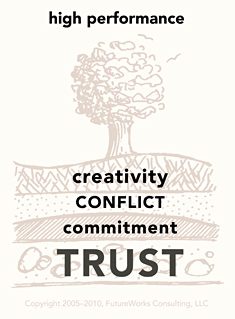
High Performance
supports and reinforces
Creativity/Innovation
supports and reinforces
Constructive Conflict
supports and reinforces
Commitment
supports and reinforces
Trust
Derek Neighbor's post about Patrick Leoncioni's team dysfunctions model prompted me to share a model I developed many years ago for work with self-directing teams. Esther Derby and I use the model as part of our "Secrets of Agile Teamwork: Beyond Technical Skills" workshop. (Next session, June 22-24 in Portland OR.)
"Generative Collaboration" (formerly known as Team Communication Model) has similarities and differences with Leoncioni's model. Similarities show up in the dynamic nature of interactions between the elements of both models and in both models' foundation in Trust. We have differences in focus and elements. Generative Collaboration provides a view of the ways healthy communication and interactions among team members contribute to passionate commitment, successful work, and high performance.
Like Leoncioni, I experience Trust as a foundation for team performance. Team members need a bedrock foundation of enough trust to begin work, then every subsequent interaction either reinforces or undermines the trust they've established.
When teams communicate and interact in ways that demonstrate a basis of sufficient trust to begin, team members find it easier to commit to the best interests of the project work and to the mutual well-being of team members. Teams need both kinds of commitment. As team members communicate and show their Commitment through exhibiting competence, willingness and other trustworthy behavior, others trust them more in a virtuous cycle.
When team members experience each other's commitment to their common purpose, they handle disagreements and Conflict effectively. The presence of conflict no longer automatically means disastrous or uncomfortable confrontation. It offers a challenge. Team members committed to a common purpose have a greater willingness to offer interpersonal feedback when issues are small, leaving them free to focus on systemic problems. They don't get sidetracked into the seductive trap of laying blame (fueling further conflict) and, consequently, reach better, faster solutions. The team experience of successfully working through conflicts and common problem-solving leads to stronger commitment and higher trust.
As the team builds its capacity for navigating conflict through healthy interactions, it also gains in capacity for Creativity and Innovation. When conflict merely indicates a need for new thinking (not potentially disastrous confrontations), team members learn how to create together, survive a respectful clash of ideas, and thrive. Many of us have had those joyous moments on teams where the push for continuous improvement and creative solutions have lead to breakthroughs. That experience also leads to more trust, commitment and interest in working through differences in approach or opinion.
Interacting and communicating from trust and commitment through constructive conflict and creativity paves the path to synergy and High Performance. How a team communicates and interacts determines the extent to which the virtuous cycle of Generative Collaboration enhances team performance.
***
I've tried several graphical designs to illustrate this model. In 1995, I started with a triangle/pyramid much like Leoncioni's. Then I moved on to a tree with its leaves as high performance and its roots in bedrock as the trust. I even tried conceptualizing it as a geyser. I'm open to ideas about how to illustrate the interaction among the dynamic elements of the model.
Comments
Diana,
Thank you for sharing the team collaboration model, it helps to visualize a real team’s growth differently. I often reflect on a team comparing vs the tuckman model, comparing vs Leoncioni’s. I guess no model will explain all reality, however its helpful have a few models so that one can probe the team living system for further discovery. Your model described above will be very useful tool for me.You had asked about diagrammatic representation, and of the options listed above, I think I like the tree best. My added 2 cents, though would be to represent Trust – as roots of the tree (seeks nourishment), commitment – as soil/ground, conflict as the surrounding environment (not so sure abou this one), creativity as new shoots/branches and performance as those well formed branches that are strong and sturdy (allows for new shoots of creativity)
Thanks for sharing
Dhaval
How about conflict as wind, maybe with clouds. It does not have to have a constant presence. It can bring freshness, but can amass into a storm…
Thanks !
Lev A.